Reserve Bank of Australia Annual Report – 1982 A Review of Monetary and External Policy
1. Background
The Australian economy entered 1981/82 with domestic demand growing strongly. Expansion was broadly based, with consumption, investment and, as a result, imports growing faster than in other recent years. Buoyant activity had been encouraged by an upsurge in resource development at a time of faster than desired growth in money and credit during 1980/81. The increases in output and employment were accompanied, however, by faster growth of wages, and by a deterioration in the external trade account.
The international background to these domestic developments remained bleak. The level of demand in industrialised countries had shown no appreciable growth since the end of 1979. With this went low growth of world trade and falling prices for many commodities. The volume and prices of Australian exports suffered accordingly. World financial markets remained unsettled, with short-term interest rates, particularly in the United States, high and volatile. A brighter spot was that world inflationary pressures were easing; this became more evident as the year progressed and was reinforced by a decline in the price of oil.
The Bank has, for some years, felt that the economy's longer-term interests are best served by the maintenance of firm and steady policies. An important element of this is the limiting of the expansion of money and credit so as not to accommodate inflationary pressures. The conditions prevailing as the economy entered 1981/82 reinforced this need. As well as the specific issues of the balance of payments deficit on current account, the upward pressure on wages and prices and the inheritance from earlier years of a too-rapid expansion in financial aggregates, there was a broader issue to be faced – could Australia continue to expand while activity in the rest of the world was stagnant?
Even though the world recession was already long by post-war standards, there was no objective basis for acting as though an upswing would occur in 1981/82. In the light of this gloomy but, in the event, correct assessment, the Bank took the view that monetary policy would have to reassert restraint. This implied accepting the higher interest rates which were coming from strong demand for finance at home and from high rates abroad. As stronger adverse trends developed in the balance of payments, particularly in the current account, the likely need for a downward tendency in the trade-weighted index of the Australian dollar became clearer. The particular policy actions described below should be seen in the light of these two broad factors.
2. Monetary and External Policy: The Course of the Year
Monetary Policy
With 1980/81 having seen a faster than desired growth of money and credit, the Bank was conscious of the need for more restraint in 1981/82. Fiscal, monetary and external policy outcomes can all affect the volume of primary liquidity, defined as private holdings of official liquid assets and government securities (LGS). By restraining growth of primary liquidity, pressure can be exerted to contain the growth of money and credit. The scope for financial intermediaries to grow can also be affected by the composition of primary liquidity, which the Bank may influence through its operations in money and capital markets. From the beginning of 1981/82, the growth of primary liquidity was more restrained than in other recent years, principally because of a large deficit on external transactions. That deficit could not be allowed to continue unabated and as the year unfolded the need for stronger domestic policy restraint became more pressing.
Australia and The World Economy
Half yearly, seasonally adjusted data



Demand for Treasury bonds through the tap system or from the Bank's portfolio was very light at the beginning of the year. Increases in tap yields on 6 July of between 0.4 and 0.8 percentage points did not result in much increase in sales. In the case of Australian Savings Bonds (ASB's), redemptions exceeded subscriptions from August 1981 and continued to do so throughout the year. From the viewpoint of the Bank's responsibilities, the attrition of household savings from ASB's was a matter of concern. The Bank put the view on a number of occasions during the year that the interest rate on ASB's should be made more competitive.
On 14 August, yields on tap stocks were raised again, this time by 1 to 1.2 percentage points. The Commonwealth's Budget, tabled on 18 August, projected a reduction in its deficit from $1,127 million in 1980/81 to $146 million in 1981/82. The higher tap rates and lower projected deficit improved the bond market. In September there were substantial sales of tap stocks and of bonds from the Bank's portfolio. These sales continued through to mid November, and were more than sufficient to offset falls in private sector holdings of Treasury notes and ASB's.
The increase in primary liquidity in the first half of 1981/82 was only about a third of that in the first half of 1980/81, principally as a result of the substantial deficit in the balance of payments. This kept pressure on short-term interest rates which, aside from a temporary decline in October and November, remained during the second half of 1981 at about the level of the previous June.
Controlled bank lending interest rates had been unaltered since December 1980, a period in which rates offered and charged by other intermediaries had risen substantially. Early in July, the Bank reminded the Treasurer of its preference to remove controls on bank interest rates. Failing agreement to that course, it saw need to increase existing interest rate ceilings on trading and savings bank loans. On 17 August the Bank, with the approval of the Treasurer, increased by 1 percentage point to 13.5 per cent (12.5 per cent for housing loans to owner-occupiers) the maximum interest rates on various categories of lending by trading and savings banks. Although a lesser increase than judged desirable by the Bank, the rise reduced the competitive disadvantage of banks and was some response to strong demand for finance.
Bank LGS ratios were relatively low but lending continued to grow quite strongly. It was not possible to be confident that adequate general policy measures would be available to slow the growth of credit. In mid September the Bank requested each major trading bank to limit the growth in its total advances to a rate of 12 per cent per annum from a base level. The base level was a figure for June 1981 for each bank which was 12.6 per cent higher than its June 1980 level of advances outstanding. The Bank recognised the limitations of, and inefficiencies caused by, direct controls over bank lending, but felt constrained by the need for tighter restraint on money and credit to have this form of credit rationing in place for the time being.
Although the growth of M3 slowed from 12.7 per cent in the twelve months to June 1981 to 10.6 per cent in the twelve months to December 1981, there was little change in the overall pace of credit expansion. This was despite some slowing in expansion by permanent building societies and finance companies. Taken in conjunction with figures for wage settlements in December, which suggested that a major acceleration in wage costs could be under way, there was doubt that monetary policy was exerting enough restraint, even though a number of factors pointed to a downturn in economic activity. Other causes for concern at the beginning of 1982 were that the Budget deficit seemed likely to exceed earlier estimates and that bond sales had petered out.
Liquidity, Money and Credit
% change from end of previous financial year

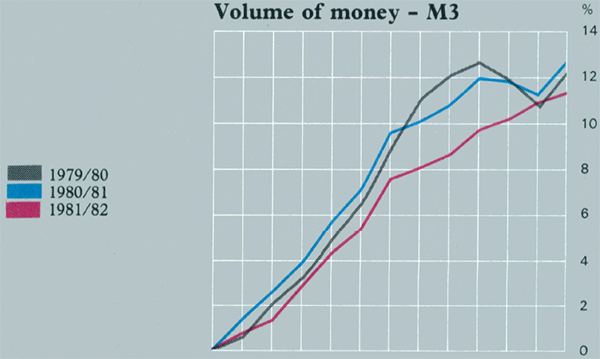
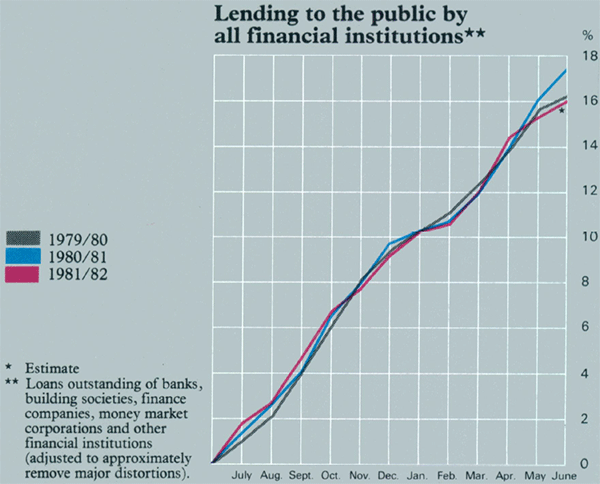
The balance of payments remained in substantial deficit as 1982 began. Its effect flowed to financial markets by retarding growth in primary liquidity in the March quarter, and short-term interest rates rose. Between end December and end February, the yield on 90-day bank bills rose by 1.4 percentage points to 17.2 per cent and the yield on 13-week Treasury notes rose by 3.0 percentage points to 16.3 per cent.
Until early February, issue yields on tap stocks had kept pace broadly with movements in secondary market trading yields. During the remainder of the March quarter and through April, a substantial gap between issue yields and market yields opened up. From mid February the Bank was looking for yields on tap stocks to be increased. With yields unchanged, sales of tap stocks during this period were minimal and the Bank made no bond sales from its portfolio. On 31 March, the Treasurer announced an increase in the interest rate on ASB's, the first since 24 March 1981. The increase of 1 percentage point, to 13.25 per cent, failed to stem the rate of disinvestment.
These shortcomings in bond marketing put more pressure on operations in short-term markets to tighten the overall setting of monetary policy so as to reduce the growth of credit in Australia and improve the overall balance of payments position. The absence of bond sales implied a need for more substantial issues of Treasury notes and this influenced amounts put to tender, particularly from the beginning of March.
Banks entered the June quarter with low free liquidity, and there was a large tax flow to the government to be financed. This prospect increased the pressure on domestic interest rates. Short-term interest rates rose through March and early April; there was a peak just before Easter when rates on 90-day bank bills rose to 22 per cent. From about mid March capital inflow picked up, reaching exceptionally high levels in the June quarter. Bank lending also rose sharply and banks competed strongly for deposits to finance lending and maintain liquidity. Growth of the money supply increased sharply at this time, but fell back in June to show growth of 11.3 per cent over 1981/82.
Short-term interest rates declined after Easter and then fell noticeably in May. Rates on slightly longer paper also fell in May and there was a marked improvement in the bond market, which had been weak for six months. Initially, sales were made from the Bank's portfolio. Following the issue of two new tap stocks on 17 May with yields of 16.4 per cent (up 1.4 percentage points), tap sales picked up for a while.
The increases in market interest rates left controlled rates on bank lending for smaller loans well out of line. This reduced the capacity of banks, particularly savings banks, to compete for deposit funds to maintain their lending, including lending for housing. On 19 March, in conjunction with some government initiatives on the provision of housing finance, the Bank, with the approval of the Treasurer, increased the maximum interest rates applying to certain advances of trading and savings banks by 1 percentage point. This brought the maximum rates on advances under $100,000 to 13.5 per cent for housing mortgages to owner-occupiers and to 14.5 per cent for other loans. At the same time, some restrictions on deposits were eased; for example, the minimum term for which trading banks were allowed to pay interest on large fixed deposits was reduced from 30 days to 14 days. Savings banks raised their deposit interest rates, but the improvement in their competitive ability was insufficient to improve their deposit performance much in subsequent months.
Towards the end of 1981/82 the Bank took steps to lessen the direct burden of monetary policy on the banks. In May, it increased the interest rate paid to trading banks on Statutory Reserve Deposits from 2.5 per cent to 5 per cent. In June, the Bank withdrew its quantitative guideline on the growth of advances to the major trading banks. The withdrawal of this guideline was seen as an adjustment in the technique of monetary management rather than a shift in monetary policy itself. It took account of recent developments in monetary management that affect liquidity generally through official actions in the market place and implied greater reliance on those techniques. It had also become increasingly clear that much of the finance unavailable through bank lending was being made available otherwise.
Shortly before the lending guideline was withdrawn, the Loan Council agreed to replace the tap system for selling Treasury bonds with a tender system, and to delegate to the Treasurer the power to determine the terms and conditions applying to ASB's. These changes hold the possibility that bond selling could become a more reliable and steady source of support for monetary policy.
Over the year as a whole, the financial situation tightened. The growth of primary liquidity was lower than in other recent years. Monetary aggregates grew a little more slowly. The rise in interest rates was sharp, particularly when seen in relation to the trend in inflation. Households and businesses felt the effects of this tightening in financial markets. Housing finance was reduced, the housing market weakened and dwelling construction fell. With a weak share market, equity raisings fell away and businesses turned to borrowings both in Australia and from abroad. As interest rates rose through the year, the cost of servicing debt rose faster than the level of borrowings. By the middle of the year, less buoyant trading conditions were also reducing businesses' cash flow. In these circumstances, and with labour costs rising and asset values fragile, it was observed that demand for credit remained high even after economic activity had slackened.
External Policy
The deficit in the current account of the balance of payments widened from the beginning of 1981/82. A greater deficit came as no surprise since domestic demand was still growing strongly in Australia while in our trading partners it was stagnant. There was also a loss of competitiveness as businesses felt the effects of the rapid increase in labour costs.
Private capital inflow did not keep up with the widening current account deficit for most of the year; in the September quarter the current account deficit was about twice as large as a year earlier but capital inflow was about the same size. An overall deficit on the balance of payments continued until March, when strong capital inflow over the remainder of the year brought the balance of payments into substantial surplus.
The loss of reserves in the first eight months of 1981/82 amounted to $1.8 billion. During this period reserves were supported by the resumption of a more regular programme of official overseas borrowing. Net official raisings overseas amounted to $387 million between July and February; in October reserves were also strengthened by a placement with the Bank of $176 million by the Bank for International Settlements; this was repaid in April 1982. Although it did not add to official reserve assets, conversion into currency of Australia's reserve tranche at the International Monetary Fund in February added to holdings of foreign exchange.
The trade-weighted index of the value of the Australian dollar, which had risen in the final months of 1980/81, was increased further in July. The index began to be moved down from early August and by end February it had been lowered by 5.5 points from its peak. Over the same period the Australian dollar fell 4.5 per cent against the US dollar, 7.9 per cent against the yen, and 10.0 per cent against the Deutschemark.
As the trade-weighted index was lowered there was increased demand by importers for forward cover. With the Bank unwilling to accept continued growth in its net oversold position, the cost of forward cover increased, and covered interest-rate differentials moved against borrowing abroad. With demand for finance (particularly to fund June quarter tax flows) very strong, domestic interest rates rose in March and a heavy inflow of capital began. The move down of the trade-weighted index paused in mid March; demand by exporters for forward cover strengthened for a time. Premiums on forward US dollars decreased and the Bank's oversold position came down. Covered interest-rate differentials tended to favour borrowing abroad for most of the June quarter. The trade-weighted index was held fairly steady over the closing months of the financial year. On 30 June the trade-weighted index was 88.2, 1.0 points down from the end February level, with the rate against the US dollar 4.8 per cent down.
Private capital inflow amounted to $5 billion in the June quarter, by far the largest quarterly inflow on record. The overall surplus in the balance of payments in the June quarter outweighed the deficit during the earlier part of the year and by June 1982 international reserves were $6,517 million, about $808 million higher than their level a year earlier.
3. Comments on Policy
At the beginning of 1981/82, the weak balance of payments and the threat of inflation and loss of competitiveness from high wage growth were the most obvious problems confronting policy. As the year progressed, it was apparent that a major downturn in economic activity was under way, and that the period of nearly two years during which Australia had been able to maintain growth during a period of international recession had come to an end. There are limits to how much economic policy can achieve in the short run and how many ends it can pursue. This is especially so at times when events beyond the control of policy are having a greater effect on the economy than can policy itself. Policy then needs to be mainly concerned with the long-run interests of the Australian economy.
The large and growing deficit on the current account of the balance of payments required a number of adjustments within the economy. If most of the adjustment were to take the form of a depreciation of the exchange rate, the immediate pressure on interest rates and the immediate threat to activity might be lessened. But there would be a danger that, by accommodating domestic cost increases and raising the domestic price of internationally-traded goods, depreciation would lead to higher inflation. If a smaller movement of the exchange rate were made, more of the immediate adjustment would be taken in higher domestic interest rates. There would be a tendency to weaker activity, particularly in those sectors which compete in the international market place, but more restraint on inflation. Over 1981/82 as a whole, the policies used represented a mixture of these two elements. Many interest rates reached historically high levels and the trade-weighted exchange rate was lowered.
Interest Rates and Exchange Rates*
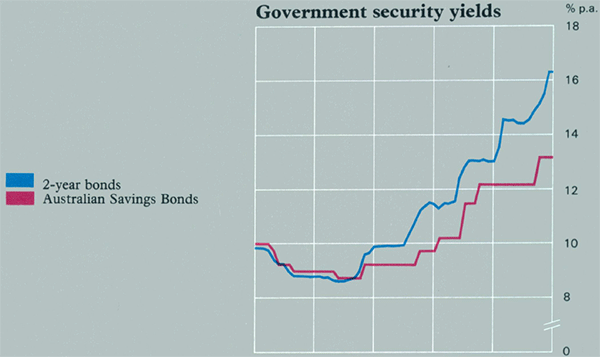
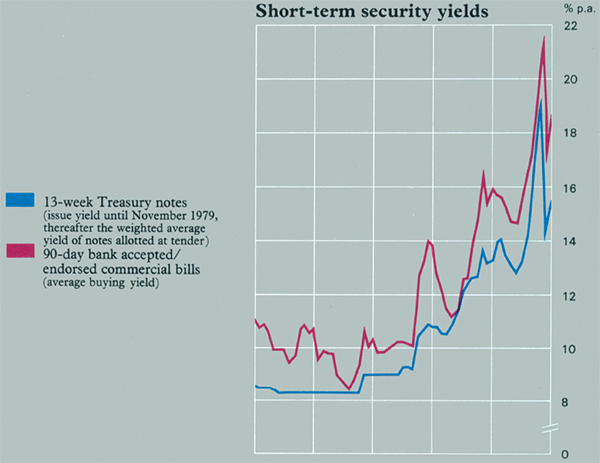
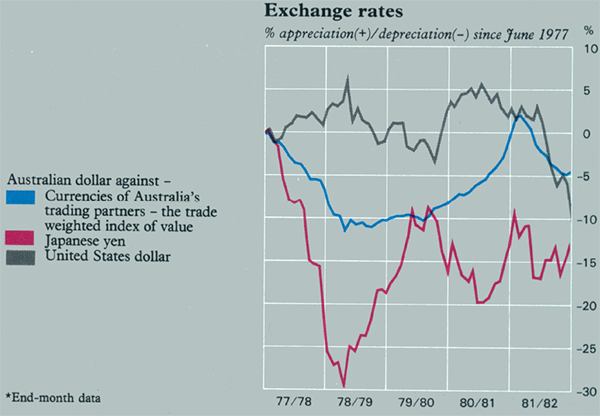
Broadly speaking, a mix which accorded with the aim of tightening monetary policy was seen as appropriate. Arising out of buoyant demand in 1980/81, and the euphoria of the resources boom, there had been a general lifting of aspirations in the economy. Signs of this were to be seen in the stock market, in the prices of physical assets (especially real estate) and in the rate of growth of wages, which had moved up markedly before the collapse of indexation. Competition to share in the benefits of the resources boom had developed before any of the benefits were in sight (the costs, on the other hand, were incurred early, as evidenced by the rapid growth of business fixed investment). For this reason policies that helped to scale down unrealistic expectations were to be preferred to ones which could be regarded, in the short run at least, as validating excessive claims.
The decline in the world's demand for our exports and in its valuation of our resources, in effect, reduced the room for incomes in Australia to grow. The sooner this was recognised and reflected in a moderation of claims on the nation's resources, the less painful would be the needed adjustment. Adverse effects of the adjustment on activity and employment would be the smaller if wages and prices were prevented from getting too far out of line with our capacity to earn our way in the world.
There was little to suggest that policy was having success in restraining wages in the first half of 1981/82, and with increased wages often being accompanied by a shorter working week, labour costs rose faster than could be absorbed without further price inflation or cost-cutting, including labour shedding. More recently there have been signs that policies may be helping to moderate the potentially dangerous wages position. Although the outlook is still uncertain, prospects for realistic moderation in wage claims seem to be a good deal better at the end of 1981/82 than they were at the beginning.
In the meantime, there has been a clear weakening in economic activity and a rise in unemployment. So far at least, the slowdown has been less pronounced than in most other countries. Moreover, the deterioration in economic activity in Australia came later in relation to the international business cycle than in the previous occasion, in the mid seventies, when high wage growth came into conflict with an international recession. Whether the setback to Australia's employment and activity will be smaller than in the mid seventies will depend largely on the duration of the international recession, and how quickly we regain wage and price competitiveness.
Although policy sought, with some success, to keep a tighter rein on primary liquidity than in previous years, there was still more than enough room for slippage. The working of the tap system of selling bonds was again intermittent. Nearly all the year's sales occurred in the two months to mid November and in May; for the bulk of the year tap yields were not attractive to investors. The interest rate on ASB's limped well behind rates on competing securities and there were net redemptions for all but the first month of the year. From about the middle of 1981/82 it was apparent that the estimated budget deficit would be exceeded by a substantial amount. If these domestic slippages did not provide sufficient liquidity to underwrite strong growth in lending, there was still ready access to very large inflows across the foreign exchanges. While these inflows can help in avoiding extreme financial stringency, they are a source of substantial uncertainty in assessing the growth path of money and credit.
Despite reduced growth of primary liquidity and much increased interest rates, the expansion of credit remained strong for most of the year. Trading bank lending did not slow noticeably until about the end of the year. Money market corporations grew rapidly. So did cash management trusts which amassed about $1.4 billion during the year. However, lending by finance companies slowed noticeably. Traditional repositories of household savings, such as savings banks and building societies, languished, with their growth inhibited by formal and informal pressures to hold interest rates below competitive market levels. This experience provided a clear example of how financial innovation can confound attempts to hold down interest rates by controlling rates on borrowing and lending by particular intermediaries.
The slowness of demand for credit to respond both to higher interest rates and weakening activity is a matter of some interest. For much of the year interest rates on bank advances were held below free market levels. Even in the case of formally uncontrolled interest rates on larger loans, banks felt constrained not to raise interest rates on advances as fast or as far as short-term market rates were rising – a factor tending to encourage demand for credit. More generally, it is common for a tightening in liquidity to have the short-run effect of increasing bank advances and other forms of finance as borrowers have recourse to unused overdraft limits or standby lines of credit. With activity slowing and unit labour costs higher, credit tended to be demanded by businesses to sustain them pending adjustment of their operations to the changed conditions.
The removal in June 1982 of the lending guideline by the Bank to trading banks was a step the Bank had been inhibited from taking earlier by the lack of fully effective techniques for affecting liquidity through official actions in the market place. Its removal draws out the importance of effective use of flexibility in the marketing of government securities and in the Bank's own operations in the market.
The removal of the guideline on bank lending, along with other changes affecting banks such as the reduction in the minimum term for fixed deposits, leaves the way open for possible shifts in sources and mechanisms of finance in the time ahead. As a consequence, the interpretation of growth rates in various monetary aggregates, and in particular M3, will require more than usual care; the statistical series will be capable of substantial and misleading shifts.
By the end of 1981/82, buoyant economic growth had given way to falling activity. Unemployment was rising; inflation was still strong. Company profits were falling. Interest rates were uncomfortably high. The economy and the policy makers were having to come to grips with persistent recession and high interest rates abroad, and excessive increases in labour costs in Australia. There was no reason to believe that a marked improvement in conditions abroad was in the offing. A quick and painless correction cannot be expected. As the community is adjusting to these tougher conditions, the need is for good sense in economic management so that, to the extent practicable, inflation is contained and the fall in activity and employment is minimised.